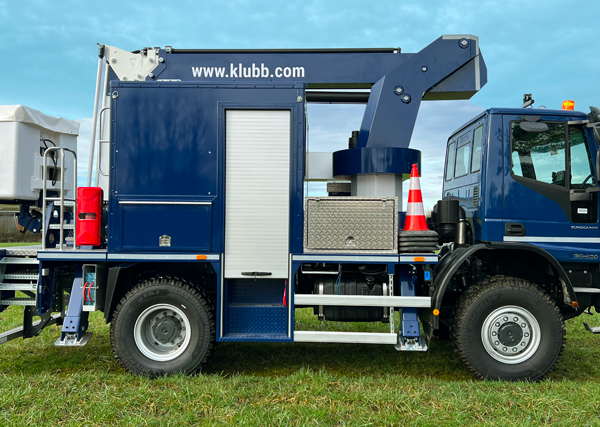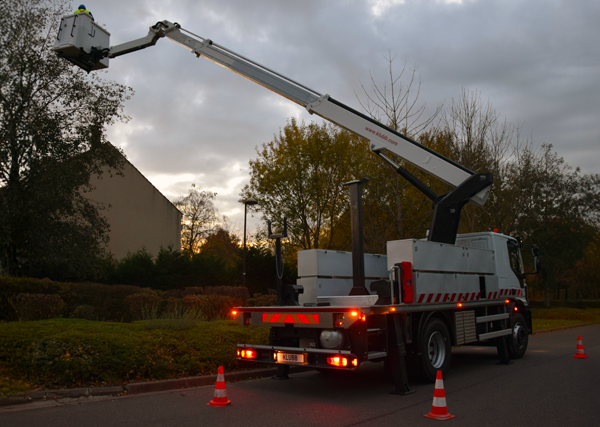
It sounds obvious that the use of an aerial work platform, whatever its type, requires to follow a particular training course. Thus you increase the safety of your operators when they are working at height.
You might not be familiar with what an aerial platform training program looks like though. Questioning what are the components of such courses.This article aims to answer that question by providing you with detailed informations about the essential components of an aerial platform training program.
Training program main topics
An aerial lift training course covers at least 6 main topics and ends up with some evaluations and a certificate. For the purpose of this article we will dive with you into these 6 main topics.
Theoretical Instruction
Like any other kind of course, the first part of an aerial work platform training program is the theoretical part. During that phase your employees will learn the basics about aerial platforms. The safety standards and regulations, the type of aerial platforms existing, the pre-operational inspections and risk assessment.
Let’s look at what each of this chapter contains.
Safety Standards and Regulations
The cornerstone of operating aerial work platforms safely lies in a comprehensive understanding of safety standards and regulations, pivotal for safeguarding those involved. In Europe, these norms are largely guided by directives such as the European Machinery Directive and harmonized standards like EN 280, which stipulate clear criteria for design, operation, and maintenance.
Mastery of these regulations empowers your team to identify potential risks, comply with load limitations, and underscores the significance of consistent equipment inspections. It's also essential for your team to stay abreast of country-specific rules, as these can differ across the European Union, reflecting local requirements and conditions.
This foundational knowledge not only drastically reduces the likelihood of accidents but also ensures adherence to legal mandates, fostering a culture of safety and responsibility in aerial platform operations.
Types of Aerial Platforms
A thorough grasp of the diverse types of aerial platforms is crucial for your team's efficiency and safety. This component delves into the various categories, such as scissor lifts, boom lifts, and cherry pickers, each with distinct capabilities and suitable applications.
Understanding these differences ensures that your team selects the appropriate equipment for specific tasks, optimizing both safety and productivity. It also includes training on the operational nuances and limitations of each type, equipping your team with the knowledge to make informed decisions on the job.
This understanding is instrumental in preventing misuse of equipment and reducing the risk of accidents due to inappropriate selection or application of aerial platforms.
Pre-Operational Inspections
Pre-operational inspections are a critical safety measure and an integral part of the training. This segment emphasizes the importance of conducting detailed checks before using any aerial platform.
Your team will learn to inspect various components such as hydraulic systems, control mechanisms, guardrails, and emergency devices. These inspections not only ensure that the equipment is in safe working condition but also help in identifying potential issues before they escalate into hazards.
Equipping your team with this knowledge fosters a proactive approach to safety, significantly reducing the likelihood of equipment-related incidents.
Risk Assessment
Risk assessment forms the backbone of safe aerial platform operations. In this section, your team will learn to systematically evaluate potential hazards associated with different tasks and environments where aerial platforms are used.
This includes identifying risks like falls, tip-overs, entrapment, or contact with electrical lines, and understanding how to mitigate them. Training your team in effective risk assessment strategies enables them to anticipate and manage dangers, creating a safer working environment.
This proactive approach not only protects the team but also ensures compliance with safety regulations and standards, fostering a culture of vigilance and responsibility.
Practical Training
The theory gives way to practice. In this second phase, your teams will be placed in real-life situations both in and out of the aerial platform because not everything happens just inside the basket. This part is divided into 3 chapters : aerial platform operation, control familiarization and emergency procedures.
Hands-On Operation
Moving from theoretical learning to real-world application, the hands-on operation component of the training is a pivotal phase for your team. In this segment, they will have the opportunity to directly operate various types of aerial platforms, transitioning knowledge from the classroom to the field.
This practical experience is crucial, as it allows your team members to apply and refine their skills in a controlled environment. They will learn to navigate the intricacies of operating these machines, understanding their responses and handling characteristics.
This hands-on approach is invaluable in building confidence and competence, ensuring your team is thoroughly prepared for the operational challenges they may face.
Control Familiarization
The control familiarization phase of the training is designed to intimately acquaint your team with the diverse control systems of aerial platforms. In this segment, they will delve into the detailed functionalities of each type of equipment, from basic operation to advanced maneuvering techniques.
This comprehensive overview ensures that team members are not only comfortable with the controls but also understand how to use them effectively and safely in various situations. It's a crucial step in building operational proficiency, as familiarity with controls is fundamental to preventing mishaps and enhancing efficiency.
By the end of this phase, your team will have developed a solid grasp of control mechanisms, paving the way for safer and more confident operations.
Emergency Procedures
The emergency procedures component is an essential aspect of the training, focusing on preparing your team for unforeseen situations. This segment educates them on how to respond swiftly and effectively to various emergency scenarios that could arise while operating aerial platforms.
It includes training on equipment malfunctions, power failures, and rescue operations. Your team will learn crucial skills like emergency descent, equipment shutdown, and communication protocols during crises.
This training is not just about handling emergencies but also about instilling a sense of calm and control in high-pressure situations, ensuring that your team can maintain safety even when faced with unexpected challenges.
Worksite Assessment
When it comes to worksite assessment, it's all about getting your team ready to understand and navigate the environment they'll be working in. This part of the training is really about opening their eyes to the unique challenges and hazards that each site may present.
They'll learn to spot potential risks like uneven terrain, overhead obstacles, or power lines, and understand how these factors can impact the safe operation of aerial platforms.
It's also about empowering your team to make smart, informed decisions on the fly, adapting to the ever-changing conditions of a worksite. This isn't just training; it's about giving your team the tools and confidence they need to assess and adapt to any situation, ensuring safety and efficiency wherever they set up.
Personal Protective Equipment (PPE)
Proper Use of PPE
Aerial platform training course is all about how to keep your team safe when working at height. That’s why your employees should know everything about the proper use of PPE - Personal Protective Equipement.
From fitting a hard hat snugly to securing a harness correctly, it's the little details that make a big difference. This isn't just about ticking boxes; it's about ingraining a safety-first mindset in your team, making sure they feel as protected and prepared as possible every time they step onto the worksite.
Inspection and Maintenance
Diving into the nitty-gritty, the focus here is on teaching your team to inspect PPE for damage or wear, turning them into safety gear detectives. They'll learn the importance of catching little signs of wear or damage that could make a significant difference in critical moments.
From frayed straps to cracked helmets, they'll scrutinize every detail, understanding that even the smallest flaw can compromise safety. This goes beyond a routine check; this training instills a habit of vigilance and care, ensuring that their protective gear is always ready to keep them safe.
Maintenance and Inspection
Routine Checks
For routine checks, your team will receive comprehensive instruction on performing maintenance and inspection of aerial work platforms (AWPs). This training equips them with the know-how to conduct regular evaluations, ensuring that the equipment is in optimal condition for safe operation. They'll learn to identify signs of wear, mechanical issues, and ensure all safety features are functioning properly. These routine checks are essential in preventing equipment failure and maintaining a safe working environment.
Troubleshooting
When it comes to troubleshooting, the training focuses on equipping your team with basic skills to tackle common issues that may arise with AWPs. They'll learn to diagnose and address simple problems, reducing downtime and enhancing operational efficiency. This doesn't just keep the workflow smooth; it also fosters a deeper understanding of the equipment, enabling your team to respond quickly and effectively to potential hiccups.
Rescue Planning
Rescue Procedures
The training segment on executing rescue plans is a crucial one, preparing your team for scenarios where someone might be stranded or injured while using an Aerial Work Platform (AWP).
It’s about equipping them with the skills and confidence to act swiftly and effectively in such emergencies. They'll learn specific procedures for safely evacuating or rescuing a person from an elevated platform, ensuring they can handle the situation with calm and competence.
This training is not only about saving time in critical moments but also about ensuring the safety and well-being of everyone involved, reinforcing the team's ability to respond to emergencies with precision and care.
First Aid
Incorporating basic first aid training into the program could indeed be incredibly beneficial, particularly for handling falls or other injuries that might occur during AWP operations. This training provides your team with essential skills to manage common injuries, such as cuts, bruises, or even more serious conditions like fractures or concussions.
It teaches them how to administer immediate and effective care until professional medical help arrives, which can be crucial in mitigating the severity of an injury. Basic first aid training not only enhances the overall safety preparedness of your team but also fosters a supportive and responsible work environment where team members are equipped to look out for one another's well-being.
Certification and Evaluation
Certification and evaluation are key components of the aerial platform training program, marking the culmination of your team's hard work and learning.
Certification serves as formal recognition that your team members have successfully completed the training and are competent in operating AWPs safely and efficiently. It typically involves a combination of written and practical tests to assess their understanding and application of the knowledge they've acquired. This certification not only boosts their professional credentials but also provides a sense of achievement and confidence in their skills.
Evaluation, on the other hand, is an ongoing process. It involves continuously assessing your team's performance, ensuring they maintain the high standards of safety and proficiency established during the training.
Regular evaluations help identify areas where refresher courses or additional training might be necessary, ensuring that your team's skills remain sharp and up-to-date. Together, certification and evaluation form the foundation of a robust safety culture, ensuring long-term competency and care in aerial platform operations.
effective aerial work platform training encompasses a broad spectrum of components, each integral to ensuring operational safety and proficiency. From understanding the types of aerial platforms to mastering control familiarization and emergency procedures, every aspect plays a vital role. Hands-on operation experience, routine checks, and troubleshooting skills are crucial for practical competency, while a deep understanding of worksite assessment and the proper use of PPE safeguards against potential hazards.




